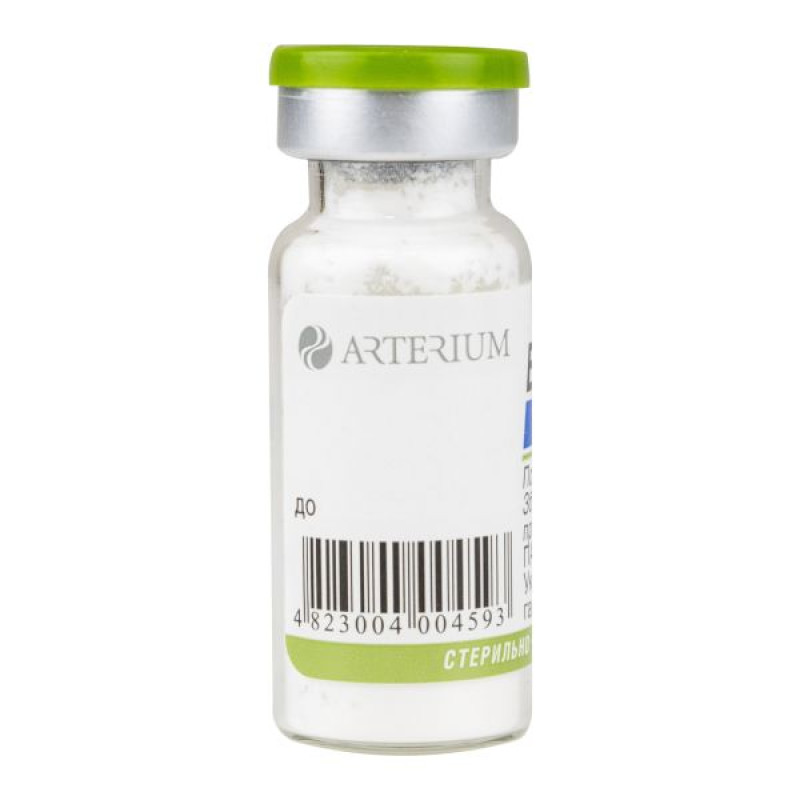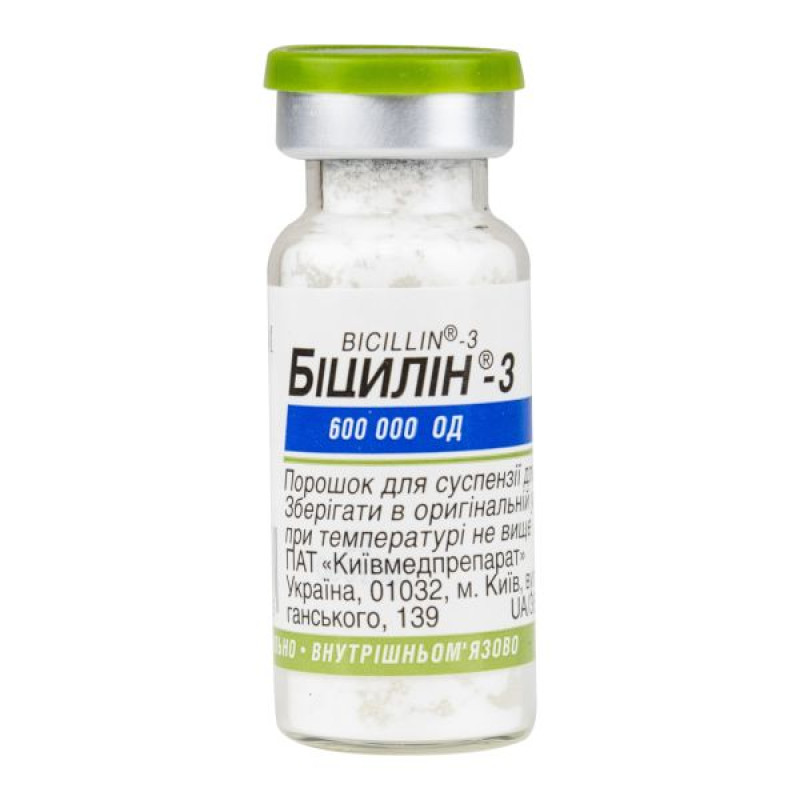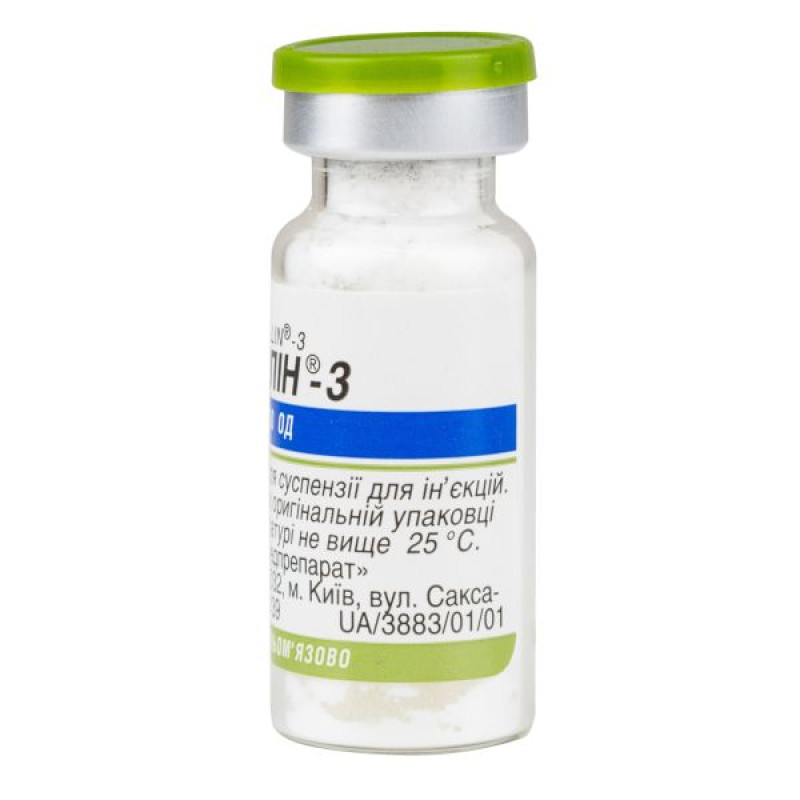Bicillin-3 powder for preparation of suspension for injection 600,000 IU vial No. 1

Instructions Bicillin-3 powder for preparation of suspension for injection 600,000 IU vial No. 1
Composition
active ingredient:
1 bottle contains: Bicillin-3, powder 600,000 U (mixture of sterile benzathine benzylpenicillin (bicillin-1) 200,000 U, sterile benzylpenicillin sodium salt 200,000 U, sterile benzylpenicillin novocaine salt 200,000 U).
Dosage form
Powder for suspension for injection.
Main physicochemical properties: white or white powder with a slightly yellowish tint.
Pharmacotherapeutic group
Antibacterial drugs for systemic use. Combinations of penicillins sensitive to the action of b-lactamases. ATX code J01C E30.
Pharmacological properties
Pharmacodynamics
The drug exhibits bactericidal action by inhibiting the synthesis of mucopeptides of the cell membrane of microorganisms. Active against gram-positive microorganisms: Staphylococcus spp. (except those that produce penicillinase), Streptococcus spp. (including Streptococcus pneumoniae), Corynebacterium diphtheriae, Bacillus anthracis; gram-negative: Neisseria gonorrhoeae, Neisseria meningitidis, Actinomyces israelii, as well as Treponema spp., anaerobic, spore-forming. Most gram-negative bacteria, mycobacteria, fungi, viruses, protozoa are resistant to the drug.
Pharmacokinetics
Bicillin is a form of benzylpenicillin with prolonged action. When administered intramuscularly, the drug forms a depot in muscle tissue. In the first hours after injection, a high level of benzylpenicillin is formed in the blood. Bicillin is well distributed in tissues and body fluids. The drug is found in high concentrations in the liver, kidneys, lungs, mucous membranes, and has the ability to penetrate fibrinous tissues. Bicillin is mainly excreted in urine in a biologically active form (50-70%), in small quantities - with saliva, sweat, milk, bile.
Indication
Treatment of infections caused by microorganisms sensitive to the drug, in cases where long-term maintenance of a constant concentration of the drug in the blood is necessary:
Respiratory tract and ENT infections: streptococcal pharyngitis and tonsillitis; genitourinary system infections: syphilis; erysipelas; exacerbation of rheumatism.
Contraindication
Hypersensitivity to β-lactam antibiotics (penicillins, cephalosporins, carbapenems), novocaine;
Bronchial asthma, urticaria, hay fever and severe allergic reactions.
Interaction with other medicinal products and other types of interactions
When used simultaneously with bactericidal antibiotics (including cephalosporins, cycloserine, vancomycin, rifampicin, aminoglycosides), synergism of action is observed; with bacteriostatic antibiotics (including macrolides, chloramphenicol, lincosamides, tetracycline) - antagonism.
Bicillin®-3 reduces the effectiveness of oral contraceptives and ethinylestradiol (risk of breakthrough bleeding). It is not recommended to combine with nonsteroidal anti-inflammatory drugs. Benzylpenicillin reduces the clearance and increases the toxicity of methotrexate.
When used simultaneously with allopurinol, the risk of allergic reactions increases.
Pharmacokinetic interaction. With simultaneous use of diuretics, allopurinol, phenylbutazone, NSAIDs reduce tubular secretion and increase the concentration of penicillin.
It should be borne in mind the possibility of competitive inhibition of the process of excretion from the body when benzylpenicillin is used simultaneously with anti-inflammatory and antipyretic agents (indomethacin, phenylbutazone, salicylates in high doses). Aspirin, probenecid, thiazide diuretics, furosemide, ethacrynic acid increase the half-life of benzylpenicillin, increasing its concentration in the blood plasma, as a result of which the risk of developing its toxic effect by affecting the tubular secretion of the kidneys increases. Allopurinol increases the risk of developing allergic reactions (skin rash).
Avoid simultaneous use with chloramphenicol, erythromycin, tetracycline, sulfonamides.
When used simultaneously with methotrexate, the excretion of the latter is reduced and the risk of its toxicity increases.
Penicillins may interfere with diagnostic tests, such as the copper sulfate urine glucose test, the direct antiglobulin test (Coombs' test), and some tests for serum protein or protein in urine. Penicillins may also interfere with tests that use bacteria, such as the Guthrie test for phenylketonuria, which uses Bacillus subtilis.
Application features
It is necessary to find out whether there were any reactions to drugs of the group (β-lactam and/or novocaine) during their previous use. The drug should be prescribed with caution to patients prone to allergic reactions. If signs of allergic reactions appear, Bicillin®-3 should be canceled and appropriate therapy should be prescribed.
In order to prevent adverse reactions, only intramuscular administration of the drug should be used.
Severe and sometimes fatal cases of hypersensitivity (anaphylactic reaction) have been reported in patients receiving penicillin therapy. Such reactions occur more frequently in patients with a known history of severe allergic reactions.
Treatment of symptoms of an anaphylactic reaction may require immediate administration of adrenaline, steroids (intravenously), and emergency treatment for respiratory failure.
The drug should be used with extreme caution in patients with hay fever, urticaria, and other allergic diseases.
Neutropenia was widespread in patients receiving high doses of β-lactams and incidence was noted in patients treated for 10 days or more. Monitoring of white blood cells is recommended for prolonged periods of high-dose treatment.
The drug is not recommended for the treatment of patients with acute lymphocytic leukemia or infectious mononucleosis due to the increased risk of erythematous skin rashes. It should be borne in mind that patients with diabetes mellitus may have reduced absorption of the active substance from the intramuscular depot.
In severe renal dysfunction, large doses of penicillin can cause cerebral disorders, seizures, and coma due to neurotoxic effects.
Caution should be exercised when using the drug in patients with severe cardiopathy, hypovolemia, epilepsy, impaired renal or hepatic function. Hepatic, renal and hematological status should be monitored during prolonged therapy with high doses.
Prolonged use of the drug may lead to the development of colonization with resistant microorganisms or yeasts. Superinfection is possible, which requires careful monitoring of such patients.
In the event of severe diarrhea typical of pseudomembranous colitis (in most cases caused by Clostridium difficile), it is recommended to stop using the drug and take appropriate measures. The use of agents that inhibit peristalsis is contraindicated. In the treatment of venereal diseases with suspected syphilis, a serological test should be performed before starting therapy and within 4 months after its completion.
To suppress or alleviate the Jarisch-Herxheimer reaction, it is recommended to administer 50 mg of prednisolone or its equivalent when the drug is first used.
In patients with syphilis in the stage manifested by damage to the cardiovascular system, blood vessels and meninges, the Jarisch-Herxheimer reaction can be avoided by using prednisolone 50 mg per day or an equivalent steroid for 1-2 weeks. Freshly prepared solutions for injection or infusion should be used immediately. Even when stored in a refrigerator, aqueous solutions of benzylpenicillin sodium decompose with the formation of decomposition products and metabolites.
Skin contact with penicillins should be avoided as sensitization may occur.
Ability to influence reaction speed when driving vehicles or other mechanisms
It is recommended to refrain from activities requiring rapid psychomotor reactions (driving, working with potentially dangerous mechanisms), taking into account possible adverse reactions from the nervous system (dizziness, headache, tinnitus).
Use during pregnancy or breastfeeding
Contraindicated.
Method of administration and doses
The drug is prescribed only to adults!
Before administration, it is necessary to collect a patient's history of drug and local anesthetic tolerance!
Bicillin®-3 should be administered only intramuscularly! Intravenous administration of the drug is prohibited!
The drug is administered to adults at a dose of 600,000 IU once every 6 days. Usually, the duration of treatment is from 3 to 12 months, depending on the severity of the disease.
Rules for preparation and administration of the suspension. Prepare the suspension aseptically, immediately before use. Add 5-6 ml of 0.9% sodium chloride solution or sterile water for injection, or 0.25-0.5% novocaine solution to the vial, mix until a homogeneous suspension is formed and inject deeply intramuscularly into the upper outer quadrant of the gluteal muscle (2 injections should be made in different buttocks).
Before injecting Bicillin®-3 suspension, make sure that the needle has not entered a blood vessel. If blood appears, the needle must be removed and the injection carried out in another place.
Children
The efficacy and safety of the drug in children have not been studied.
Overdose
Toxic effects on the central nervous system are possible, namely: reflex excitation, headache, nausea, vomiting, convulsions, myalgia, arthralgia, symptoms of meningism, coma. In such cases, the administration of the drug should be discontinued.
Treatment: symptomatic, which includes hemodialysis, peritoneal dialysis, special attention should be paid to restoring water and electrolyte balance.
Adverse reactions
On the part of the immune system: hypersensitivity reactions, including skin rashes, itching, fever, chills, arthralgia, edema, urticaria, erythema multiforme exudative, exfoliative dermatitis, contact dermatitis; anaphylactic or anaphylactoid reactions, including bronchial asthma, thrombocytopenic purpura, gastrointestinal symptoms, angioedema, anaphylactic shock, which can be fatal in case of untimely and poor-quality medical care; serum sickness, possible reactions at the injection site.
Respiratory system: bronchospasm, laryngospasm.
From the side of the central and peripheral nervous system: dizziness, headache, tinnitus.
On the part of the digestive tract: nausea, vomiting, stomatitis, glossitis, black tongue, diarrhea, pseudomembranous colitis, hepatitis, bile stasis.
From the genitourinary system: interstitial nephritis.
From the cardiovascular system: fluctuations in blood pressure, impaired myocardial pumping function, tachycardia.
Blood and lymphatic system disorders: eosinophilia, positive Coombs test, hemolytic anemia, leukopenia, neutropenia, thrombocytopenia, agranulocytosis.
Local reactions: possible reactions at the injection site, including pain.
Others: in debilitated patients, newborns, and the elderly, with prolonged treatment, superinfection caused by drug-resistant microflora (yeast-like fungi, gram-negative microorganisms) may occur. In patients undergoing treatment for syphilis, a Jarisch-Herxheimer reaction secondary to bacteriolysis may also occur, which is characterized by the following symptoms: fever, chills, myalgia, headache, exacerbation of skin symptoms, tachycardia, vasodilation with changes in blood pressure.
The reaction can be dangerous in cardiovascular syphilis or conditions in which there is a serious risk of increased local damage, such as optic nerve atrophy.
Expiration date
4 years.
Storage conditions
Store in the original packaging at a temperature not exceeding 25 °C.
Keep out of reach of children.
Packaging
600,000 units in vials.
Vacation category
According to the recipe.
Producer
PJSC "Kyivmedpreparat".
Location of the manufacturer and its business address
Ukraine, 01032, Kyiv, Saksaganskoho St., 139.
There are no reviews for this product.
There are no reviews for this product, be the first to leave your review.
No questions about this product, be the first and ask your question.








